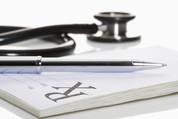GALLSTONES
SIGNS AND SYMPTOMS :
Gallstones cause symptoms when they lodge in the duct or tube that empties the gallbladder. The most frequent symptom is pain in the
upper abdomen, either in the center of the abdomen just below the breastbone, or beneath the right ribs. The pain usually lasts no more than minutes to a few hours, and most often occurs following
meals, especially fatty meals. Sometimes the pain can awaken the patient in the early morning hours. In some patients the pain appears to penetrate through to the right back, and many people
experience nausea. If the stone that blocks the outlet of the gallbladder lodges, infection can set up in the gallbladder causing the complication of cholecystitis. This can then lead to the
necessity of emergency treatment.
HOW ARE GALLSTONES DIAGNOSED?
The Doctor will suspect gallstones from listening to your history, examining you, and perhaps also blood and urine tests. However, to prove gallstones requires imaging (scanning):
Ultrasound: More properly called ultrasonographic scanning (USS), this is the same scanning technique used to observe the unborn baby in the womb. It uses sound waves and is totally safe and painless. Sound waves bounce off gallstones and the reflections show on a video screen.
Cholangiography: Depending on the complications which gallstones cause, it may be necessary to look for gallstones in the bile duct as well as the gallbladder. This can be done in a variety of ways. The simplest way is to inject dye into the bile duct during a gallbladder operation, 'intra-operative cholangiography', but it is not necessary to have an operation to do this. At Endoscopic Retrograde Cholangio-Pancreatography (ERCP), dye can be injected through a swallowed telescope (endoscope) backwards up into the bile and pancreatic ducts. Bile duct gallstones can be removed through the telescope, but not those in the gallbladder. Because there are some slight risks of ERCP, and because it is not always possible to inject dye into the bile duct, a new scanning technique called Magnetic ResonanceCholangio-Pancreatography (MRCP) has been developed
WHAT TREATMENTS ARE POSSIBLE?
By surgery, diet or drugs:
Surgery: The treatment is usually surgical, removing gallstones and
the gallbladder which causes them to form. The operation is 'cholecystectomy' and is safe for most patients. Living without a gallbladder is perfectly normal, and life is usually very much improved
after surgery. Most surgeons now perform cholecystectomy using a video camera mounted on a telescope (laparoscope) passed through the
umbilicus (tummy button) and several other small 'keyhole' incisions, avoiding a big, painful scar. The camera sends a magnified image to a video monitor, giving the surgeon a close-up view. The
operation is performed by manipulating the surgical instruments through the three other 'keyholes', usually three. The gallbladder is identified and carefully separated from the liver and other
structures. Finally, the gallbladder is disconnected from the bile duct and removed through one of the small incisions. It usually means a day or two in hospital at the most and a further two weeks'
convalescence. It results in less pain, quicker healing, improved cosmetic results, and fewer complications. One serious complication which can occur, however the gallbladder is removed, is injury to
the bile duct, which connects the gallbladder and liver. This may cause a painful and potentially dangerous infection and may require corrective surgery, but this is rare. Meticulous surgical skill
and training help to prevent, as may the performance of cholangiography prior to disconnecting the gallbladder from the bile duct. Sometimes complications such as adhesions, severe inflammation or
bleeding occur, forcing the surgeon to switch to the 'open' cholecystectomy using a standard incision for safety. This now happens in less than 5% of cases, and in expert centres, less than 1%. A
longer convalescence will be required. A US Consensus Development Conference panel by
the National Institutes of Health, in September 1992, endorsed laparoscopic cholecystectomy as safe and effective, equal in efficacy to open surgery, but noted that it should be performed only by
experienced surgeons and only on patients who had symptoms of gallstones. The panel noted that outcome was greatly influenced by training, experience, skill, and judgment of the surgeon and
recommeded strict guidelines for training, credentialing, determining competence, and monitoring quality.
Diet: A diet high in fibre (roughage - fruit and vegetables) and low in fat may help by reducing gallbladder stimulation, but this is usually a holding measure for most patients.
Drugs etc: Drug treatments are designed to dissolve gallstones, but few people respond to this and it may take months or years to work, whilst the gallstones still symptoms. Mild diarrhoea is common. They may reform after dissolution. Gallstones in the bile duct can be treated by ERCP as outlined above. As this does not remove the diseased gallbladder, operation may still be required.
For further consultation please book an appointment with one of our highly experienced doctors by calling us on 0091-11-26680759 or emailing us at reception@tirupatimedicalcentre.com



